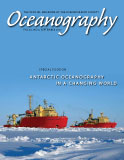Article Abstract
Significant strides in our understanding of the marine pelagic ecosystem of the Western Antarctic Peninsula (WAP) region have been made over the past two decades, resulting from research conducted aboard ARSV Laurence M. Gould and RVIB Nathaniel B. Palmer. These advances range from an understanding of the physical forcing on biology, to food web ecology (from microbes to top predators), to biogeochemical cycling, often in the larger context of rapid climate warming in the region. The proximity of the WAP to the Antarctic Circumpolar Current and WAP continental shelf bathymetry affects the hydrography and helps structure the biological community. Seasonal, spatial, and interannual variability at all levels of the food web, as well as the mechanisms supporting their production, are now more clearly understood. New tools and technologies employed in the region were critical for making this research possible. As a result, our knowledge of the WAP pelagic ecosystem during a time of rapid climate change has vastly improved.

